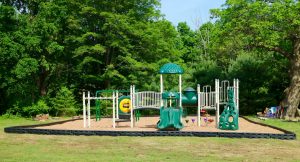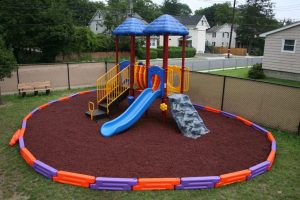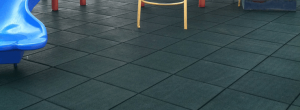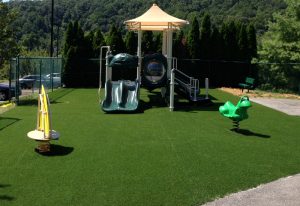 Equipment’s falling heights
Equipment’s falling heights
Playgrounds must have resilient surfacing that can protect children should they fall off of the play equipment. Each type of playground equipment has its own fall height that inspectors check. Check what these standards are for the equipment you have on your playground.
- Swings
- Slides
- Monkey Bars
- Stepping Pods
- Balance Beams
- Spring Riders
- Merry-Go-Rounds
- Climbers
- Sand Boxes
Surfacing is a certain depth based on the height of a playground, so appropriate surfacing and appropriate fall heights on equipment should coincide. Incorrect surfacing or surface depth will not accommodate to the safety of children should they fall.
Materials that are not appropriate for protective surfacing include
- Concrete
- Asphalt
- Packed Earth
- Grass
CPSC 2.4.2
Many playgrounds are outdated with old equipment. At Trassig we encourage everyone to educate themselves on playground standards in order to better understand and to be aware of playground safety.
There are many different options for safety surfacing on playgrounds. ^Check out our complete surfacing guide for more information.^
 Engineered Wood Fiber
Engineered Wood Fiber
EWF is better than woodchips because it is IPEMA certified, cut into uniform sizes and made from virgin wood. The minimum for EWF as surfacing is nine inches thick and will increase depending on fall height. Playground installations will be 10 to 11 inches. EWF needs to meet ADA standards which means that people with disabilities must be able to access playgrounds with EWF surfacing. EWF is not the best choice for accessibility because people with wheelchairs may not be able to reach the playground easily.
Out of all safety surfacing options, EWF needs the most maintenance. It will decompose and compact itself down. We recommend installing a post to measure the difference in height over time. You will need to maintain the original height in order to keep the correct fall height. EWF needs good draining when it is installed or else it will freeze in the winter. Also, to maintain ADA and fall height compliance, it must be regularly raked. If you have EWF, you’ll notice wear in high traffic areas. Use rubber mats to cover these areas and avoid this problem.
 Shredded Rubber
Shredded Rubber
Shredded Rubber is a good option when it comes to maintenance because it does not require much. You may need to buy a bag a few times to replenish displaced pieces and you may need to occasionally rake the area to even it out. We’d also recommend rubber mats in high traffic areas for shredded rubber as well. The minimum thickness for shredded rubber as surfacing is six inches.
One upside to choosing shredded rubber is that it benefits the environment. The rubber comes from old tires that would otherwise be sitting in a landfill. However, there is the possibility that toddlers can put the small sheddings of rubber into their mouths and choke.
 Rubber Tiles
Rubber Tiles
Rubber Tiles are a very low maintenance choice for surfacing. You can easily swap out an old tile for a new one. One benefit to tiles is that they are very ADA compliant as those in wheelchairs can easily wheel across them. Also, they are environmentally sound, and like other rubber surfacing options, they keep tires out of landfills.
 Synthetic Turf
Synthetic Turf
Our synthetic turf is made from polyethylene which is soft and unabrasive. Padding that is two inches thick (or more depending on fall height) is underneath the turf to protect from impact. Turf from the USA is safer than internationally shipped turf as it cannot contain lead. Installed turf should have correct documentation to confirm that it is safe for humans.
Turf must have proper drainage before being installed and have crushed stone compacted underneath. As far as maintenance for turf, it should occasionally be sanitized, leaf-blown, and brushed with a power broom.
 Poured in Place Rubber
Poured in Place Rubber
Poured in is well suited for ADA accessibility as it is flat however it is easily worn down and can require a lot of maintenance. This means that holes can appear and make the surface less accessible. PIP requires a base layer made of tire buffings and a wear layer made from EPDM rubber granules. This makes PIP environmentally friendly because it keeps tires out of landfills.
The buffings base layer achieves impact attenuation. Its thickness should be an inch and half for a four-foot fall height. Substrate under poured in can either be concrete, asphalt, or crushed compacted aggregate. Like EWF and turf, you need draining. Maintenance includes sanitizing occasionally and leaf blowing the surface. After wear, maintenance can include a patch kit, rebinder, or replacement.
PIP should not be shoveled in the winter, stepped on in stiletto heels, and once granulation occurs it must be resealed.
More on Equipment Safety
All surfacing options have benefits and drawbacks. ADA compliance and fall height compliance are the most important things to focus on when deciding on a surface. Rubber mats can be a solution to this problem on any surface. They allow for wheelchair access and stop surface displacement.
Equipment that is in motion should be separate from other equipment. Some examples include swings or seesaws. They can be hazardous if they’re too close to other objects, moving or otherwise.
All platforms should have guardrails to avoid falls.

